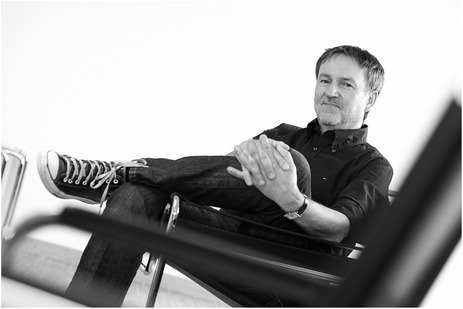Abstract

Stefan Jentsch reclining in his favorite Le Corbusier chair.
Photography by Axel Griesch, with permission from Max Planck Institute of Biochemistry, Martinsried/Munich, Germany.

With immense sadness, the scientific community along with family and friends mourns the death of Stefan Jentsch, who passed away on October 29, 2016, after a brief struggle with rapidly progressing cancer. Stefan was an iconic figure who shaped the field of ubiquitin modification for three decades with passionate curiosity, creativity, and continuous excitement for mechanistic concepts. It is difficult to single out one particular discovery of Stefan's. His highly innovative and rigorous work led to several landmark findings in research topics crossing the borders between ubiquitin biology, DNA repair, RNA splicing, and autophagy. Stefan's visionary work, charismatic personality, and groundbreaking achievements inspired many students and colleagues across the world.
Stefan was born and raised in Germany in the western part of Berlin. The city's division at that time early on stimulated Stefan's interest for history, archaeology, politics, arts, and culture. In 1983, he obtained his PhD for work on proteins modulating chromatin organization under the guidance of Thomas Trautner at Berlin's Max Planck Institute of Molecular Genetics. For his postdoc, Stefan's instinct for emerging research topics brought him to greater Boston in the United States, to study the ubiquitin conjugation system in the laboratory of Alexander Varshavsky at the Massachusetts Institute of Technology (MIT). In these early days of the ubiquitin field, Stefan made a breakthrough discovery by identifying yeast RAD6 as one of the first E2 ubiquitin‐conjugating enzymes—this was the first observation connecting the RAD6 DNA damage tolerance pathway with ubiquitin modification. Years later, Stefan's group would identify the DNA polymerase processivity factor PCNA as a central substrate of this E2 enzyme.
Already a rising star in the field, Stefan returned to Germany in 1988 and joined the Friedrich Miescher Laboratory of the Max Planck Society in Tübingen to establish his own research group. Over the next years, his team kept characterizing one E2 enzyme after the other, each yielding important insights into ubiquitin signaling. Seminal discoveries of this period—including the role of ubiquitin modification for endoplasmic reticulum‐associated protein degradation (ERAD), cell cycle progression, and cellular stress resistance—greatly stimulated the entire field. Following several subsequent offers from universities all over Germany, Stefan eventually joined one of the most vibrant places of that time, the Center of Molecular Biology in Heidelberg (ZMBH), where he became a full professor in 1993.
Stefan was gifted with great intuition and had the courage to make unconventional, groundbreaking predictions. He liked to follow novel, surprising observations and was always excited to strike new paths of research. After becoming a director at the Max Planck Institute of Biochemistry in Martinsried/Munich in 1998, Stefan ultimately became a world‐leading scientist. He now broadened his research interests beyond ubiquitin, extending it to ubiquitin‐like proteins such as RUB1/NEDD8, SMT3/SUMO, HUB1, and ATG8. Among other highlights, his work identified E4 enzymes that catalyze the extension of preformed ubiquitin chains and trigger protein degradation locally in the nucleus. His group also unraveled an intricate crosstalk between ubiquitin and SUMO in DNA replication and DNA damage repair and described a previously unrecognized DNA–protein crosslink repair pathway. Recently, his laboratory identified a new family of ubiquitin‐binding CUE domain proteins, which mediate clearance of aggregation‐prone proteins by ubiquitin‐ATG8‐dependent autophagy.
Such exceptional discoveries obviously required skilled hands and passionate co‐workers, and Stefan was an inspiring and very supportive mentor. He had an unerring gut instinct for selecting the most talented and driven students and postdocs, many of whom went on to pursue successful academic careers of their own. The atmosphere in his laboratory was unique, and Stefan's open‐door policy invited everyone to step into his office to discuss both scientific and private problems. He was also eager to engage in non‐scientific conversations, revealing his familiarity with topics such as design, fine arts, and culture, as well as his passion for travel.
Those who met Stefan at scientific conferences would remember him as an outstanding speaker, whose talks were perfectly tailored to his audience. He could summarize complicated results in beautifully simple models, which he designed with an artistic sense for self‐explanatory layout and design. Colleagues who were fortunate to know him personally remember Stefan's positive, charismatic, and generous character, as well as his wry sense of humor. His outstanding research was recognized by various prestigious awards, including the Gottfried Wilhelm Leibniz Prize, the Otto Bayer Award, the Max Planck Research Award, and the Louis‐Jeantet Prize for Medicine. Irrespective of all his accomplishments, Stefan however always kept a modest and unpretentious attitude.
Stefan Jentsch was an unconventional and visionary scientist, whose work and life should continue to inspire future generations of researchers. To many of us, he was a fine colleague and dear friend. We will continue to treasure you in our memories and will always miss you Stefan!


